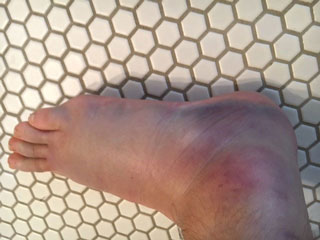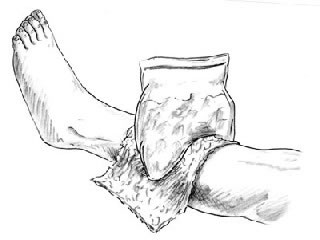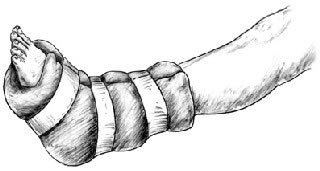Photos

Ankle sprain
This shows a sprained ankle. The ankle and foot are swollen because they were not wrapped with an elastic bandage right after the injury.
First Aid Care Advice for Ankle Sprain:
- Wrap with a snug elastic bandage.
- Apply an ice pack (crushed ice in a plastic bag covered with a towel) to reduce swelling and pain.
Source: Self Care Decisions, LLC
Used with Permission from Schmitt Pediatric Guidelines LLC.

FIRST AID Advice - Bleeding Wound of the Leg
- Apply direct pressure to the entire wound with a sterile gauze dressing or a clean cloth. Once the bleeding has stopped, cover with an adhesive bandage or gauze.
Source: Self Care Decisions, LLC
Used with Permission from Schmitt Pediatric Guidelines LLC.

FIRST AID Advice - a Minor Leg Injury (Bruise, Sprain, Strain)
- Apply a cold pack or an ice bag (wrapped in a moist towel) to the area for 20 minutes. Repeat in 1 hour, then every 4 hours while awake.
Source: Self Care Decisions, LLC
Used with Permission from Schmitt Pediatric Guidelines LLC.

FIRST AID Advice - Splint for Ankle Fracture or Dislocation
- Wrap a large soft pillow around ankle and foot. Reason: to support the ankle and foot and keep bones from moving around.
- Use tape to hold the pillow in place.
Source: Self Care Decisions, LLC
Used with Permission from Schmitt Pediatric Guidelines LLC.